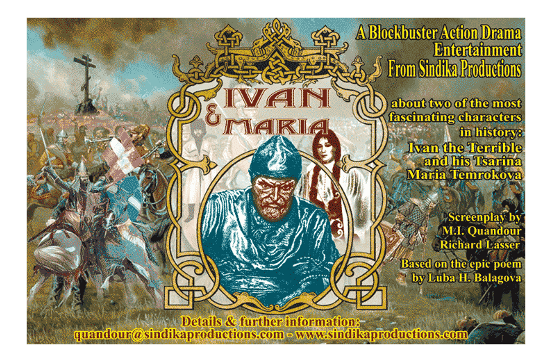Ivan & Maria
 Synopsis
Synopsis
Russia, 1561. TSAR IVAN IV (THE TERRIBLE) is a sadistic brute. He is also a scholar, religious devotee, paranoid schizophrenic and a sex maniac. And Ivan is at war. Poland-Lithuania, his enemies to the northwest and the Crimean Tatars, his enemies to the south, threaten to dismantle the fragile empire Ivan is trying to assemble through a combination of brute force, diplomacy and marriage.
But his most dangerous enemies are Russian. Two princely clans, the Yurievs and the Staritskii maneuver against the Tsar – and each other -- to sow discord among the aristocracy and line up support for a coup. And the church, under ARCHBISHOP MAKARII, constantly interferes with Ivan’s arbitrary and horrifically brutal manner of dealing with the princes and the Boyars.
But the Tsar has a secret weapon. His second wife, MARIA, a passionate, stupendous beauty from the Caucasus, pledges her allegiance only to Ivan, and they adore each other, in spite of Kremlin intrigues and Ivan’s serial infidelities – with both men and women. Under Ivan and Maria, Russia expands its borders, introduces printing and builds a powerful economy linking the Far East with Europe.
But when Maria sees the princes getting traction on their plans to overthrow Ivan, she encourages him to abdicate the throne, to go before the common people who adore him, and blame the princes.
The peasants predictably revolt, take out their anger on the princes, who have no choice but to come before Ivan with Makarii and beg him to return to the throne – on his terms. Ivan agrees, but things will be different now.
He divides the country’s leaders into two classes: the trusted Oprichnina, which he leads; and the Zemschina. The black-clad Oprichnina operate as a law unto themselves, arresting, trying and punishing supposed traitors and their retinue in ways too grotesque to imagine.
Fueled by his increasingly serious bouts of paranoid schizophrenia, Ivan imagines enemies everywhere -- sweeps the country up in a maelstrom of unspeakable cruelty. The church and the Zemschina fail at every attempt to rein in the increasingly unstable, increasingly violent Tsar.
Maria is the only one who can soothe the raging beast. And she becomes the focus of those who would seek to bring instability to the regime by any means. Her death by poison and that of their infant son, usher in perhaps the bloodiest period in all Russian history.
